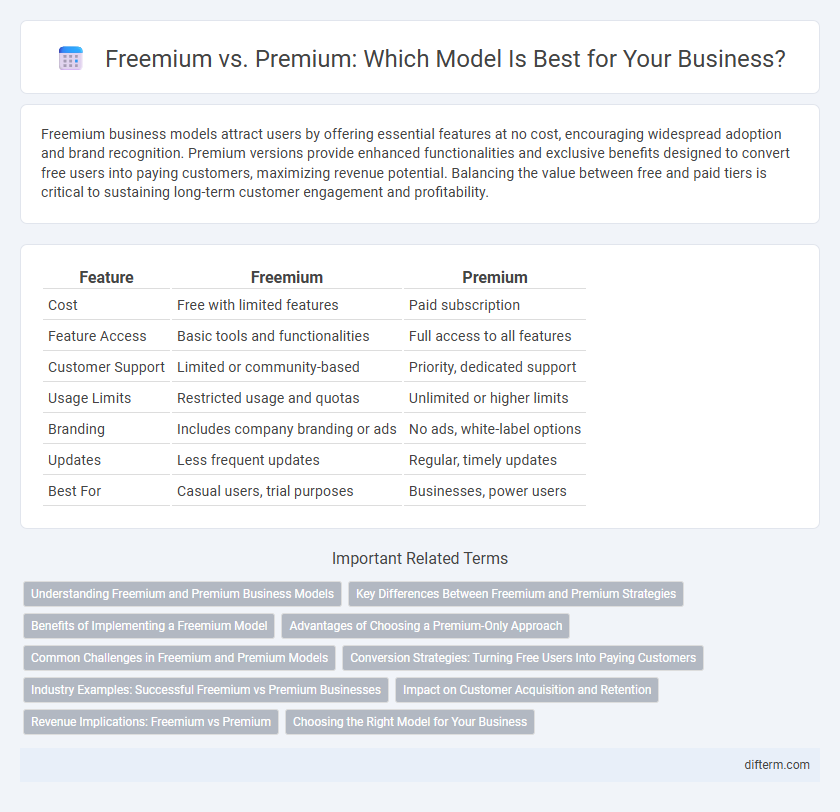Freemium business models attract users by offering essential features at no cost, encouraging widespread adoption and brand recognition. Premium versions provide enhanced functionalities and exclusive benefits designed to convert free users into paying customers, maximizing revenue potential. Balancing the value between free and paid tiers is critical to sustaining long-term customer engagement and profitability.
Table of Comparison
| Feature | Freemium | Premium |
|---|---|---|
| Cost | Free with limited features | Paid subscription |
| Feature Access | Basic tools and functionalities | Full access to all features |
| Customer Support | Limited or community-based | Priority, dedicated support |
| Usage Limits | Restricted usage and quotas | Unlimited or higher limits |
| Branding | Includes company branding or ads | No ads, white-label options |
| Updates | Less frequent updates | Regular, timely updates |
| Best For | Casual users, trial purposes | Businesses, power users |
Understanding Freemium and Premium Business Models
Freemium and premium business models differ primarily in access and monetization strategies; freemium offers basic services for free while charging for advanced features, attracting a wide user base and converting a fraction into paying customers. Premium models require upfront payment or subscription, providing full access to services with enhanced value, targeting customers committed to quality and exclusivity. Companies leverage freemium to scale quickly and build engagement, whereas premium focuses on high revenue per user and fostering strong customer loyalty.
Key Differences Between Freemium and Premium Strategies
Freemium strategies offer basic features at no cost while charging for advanced functionalities, aiming to attract a large user base and convert a fraction into paying customers. Premium strategies require upfront payment, providing full access to all features, catering to users seeking comprehensive value without limitations. Key differences include user acquisition approach, revenue generation timing, and customer lifetime value potential, with freemium emphasizing scale and premium focusing on immediate revenue.
Benefits of Implementing a Freemium Model
Implementing a freemium model drives user acquisition by removing barriers to entry, allowing potential customers to experience core features at no cost. This strategy generates a broad user base, increases brand visibility, and facilitates data collection for targeted marketing and product improvements. Conversion rates improve as users upgrade to premium offerings to access enhanced functionalities and exclusive content, boosting long-term revenue.
Advantages of Choosing a Premium-Only Approach
Choosing a premium-only business model ensures a consistent revenue stream by targeting customers willing to pay for enhanced features and exclusive content, which increases profitability and reduces reliance on upselling freemium users. It fosters higher customer lifetime value through premium service delivery, providing better resources for innovation and quality improvements. This approach also cultivates a dedicated, engaged user base, leading to stronger brand loyalty and reduced churn rates.
Common Challenges in Freemium and Premium Models
Freemium models often face challenges with user conversion rates, as a significant percentage of free users do not upgrade to paid versions, impacting revenue growth. Premium models encounter difficulties in pricing strategies that balance perceived value and market competitiveness while ensuring customer satisfaction. Both models must address customer retention and engagement to sustain long-term profitability and minimize churn rates.
Conversion Strategies: Turning Free Users Into Paying Customers
Effective conversion strategies for freemium business models emphasize targeted feature gating, offering essential functionalities for free while reserving advanced tools for premium tiers. Utilizing behavioral data, businesses can personalize upgrade prompts, showcasing the value and return on investment premium plans deliver to specific user segments. Implementing time-limited trials and in-app messaging increases urgency and user engagement, significantly boosting conversion rates from free to paying customers.
Industry Examples: Successful Freemium vs Premium Businesses
Spotify exemplifies a successful freemium model by offering free, ad-supported streaming alongside premium subscriptions with enhanced features, driving rapid user growth and revenue. In contrast, Apple's premium strategy focuses on high-quality products with a unified ecosystem, commanding higher price points and fostering strong brand loyalty. Both models demonstrate viable pathways: freemium businesses leverage wide accessibility to convert users, while premium businesses emphasize exclusive value to justify premium pricing.
Impact on Customer Acquisition and Retention
Freemium models drive rapid customer acquisition by removing entry barriers, allowing users to experience core features without upfront costs, thus expanding the user base quickly. Premium offerings enhance customer retention by delivering advanced functionalities and personalized support that increase perceived value and satisfaction over time. Balancing freemium accessibility with premium exclusivity optimizes the customer lifecycle, maximizing both growth and long-term loyalty in competitive markets.
Revenue Implications: Freemium vs Premium
Freemium models generate revenue primarily through a small percentage of users converting to paid tiers, often requiring a large user base to achieve significant income, while premium models rely on upfront payments or subscriptions, ensuring immediate and predictable cash flow. The freemium approach can lead to higher customer acquisition rates but involves ongoing costs related to free user support and infrastructure. Premium pricing strategies maximize revenue per user and reduce churn risks but may limit market penetration compared to freemium offers.
Choosing the Right Model for Your Business
Selecting the appropriate business model requires evaluating customer behavior, revenue goals, and product value. Freemium models attract a larger user base by offering basic features for free while encouraging upgrades through premium benefits. Premium models prioritize upfront revenue and cater to users seeking comprehensive, high-quality experiences without free tier limitations.
freemium vs premium Infographic

 difterm.com
difterm.com